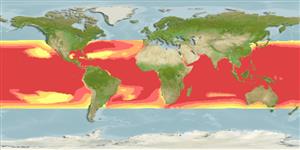Teleostei (teleosts) >
Scombriformes (Mackerels) >
Gempylidae (Snake mackerels)
Etymology: Gempylus: Greek, gempylos = a kind of fish (Ref. 45335).
More on author: Cuvier.
Environment: milieu / climate zone / depth range / distribution range
Ecology
Marine; pelagic-oceanic; oceanodromous (Ref. 51243); depth range 0 - 600 m (Ref. 13628), usually 0 - 200 m (Ref. 89423). Deep-water; 42°N - 40°S, 180°W - 180°E (Ref. 6181)
Worldwide in tropical and subtropical seas. Adults also often caught in temperate waters. Specimen caught on the Atlantic side of South Africa (33°08'S 16°47'E at 700 m) (Ref. 6193) probably strayed from the Indian Ocean.
Length at first maturity / Size / Weight / Age
Maturity: Lm ?, range 50 - ? cm
Max length : 100.0 cm SL male/unsexed; (Ref. 6181); common length : 60.0 cm SL male/unsexed; (Ref. 6181)
Dorsal
spines
(total): 27 - 33;
Dorsal
soft rays
(total): 10-14;
Anal
spines: 3;
Anal
soft rays: 10 - 12;
Vertebrae: 48 - 55. Body is elongated and strongly compressed. The mouth is large with fang-like teeth. There are two lateral lines, both originating below the first spine of the dorsal fin. The upper lateral line follows the dorsal contour of the body to the end of the first dorsal fin base. The lower descends gradually posterior to about the tip of the pectoral fin and runs mid-laterally. Body color is uniformly dark brown; all fins dark brown with somewhat darker margins.
Strictly oceanic and usually solitary (Ref. 6181). Adults migrate to the surface at night while larvae and juveniles are found near the surface during the day (Ref. 6181). Feed on fishes, cephalopods and crustaceans (Ref. 9302). Males mature at 43 cm SL, females at 50 cm (Ref. 36731). Eggs and larvae are pelagic (Ref. 6766). Sold frozen, as sausages or fish cake (Ref. 9302). Not eaten raw, but cooked in any way, also dried (Ref. 7364).
Nakamura, I. and N.V. Parin, 1993. FAO Species Catalogue. Vol. 15. Snake mackerels and cutlassfishes of the world (families Gempylidae and Trichiuridae). An annotated and illustrated catalogue of the snake mackerels, snoeks, escolars, gemfishes, sackfishes, domine, oilfish, cutlassfishes,. scabbardfishes, hairtails, and frostfishes known to date. FAO Fish. Synop. 125(15):136 p. (Ref. 6181)
IUCN Red List Status (Ref. 130435)
Threat to humans
Harmless
Human uses
Fisheries: minor commercial; bait: occasionally
More information
ReferencesAquacultureAquaculture profileStrainsGeneticsElectrophoresesHeritabilityDiseasesProcessingNutrientsMass conversion
Tools
Special reports
Download XML
Internet sources
Estimates based on models
Preferred temperature (Ref.
123201): 18.1 - 29, mean 27 °C (based on 7334 cells).
Phylogenetic diversity index (Ref.
82804): PD
50 = 1.0000 [Uniqueness, from 0.5 = low to 2.0 = high].
Bayesian length-weight: a=0.00363 (0.00163 - 0.00807), b=3.10 (2.91 - 3.29), in cm total length, based on LWR estimates for this (Sub)family-body shape (Ref.
93245).
Trophic level (Ref.
69278): 4.4 ±0.70 se; based on food items.
Resilience (Ref.
120179): Medium, minimum population doubling time 1.4 - 4.4 years (Fec=300,000).
Fishing Vulnerability (Ref.
59153): High to very high vulnerability (73 of 100).
Nutrients (Ref.
124155): Calcium = 17.3 [7.9, 36.6] mg/100g; Iron = 0.438 [0.205, 0.947] mg/100g; Protein = 17.5 [15.2, 19.5] %; Omega3 = 0.256 [0.139, 0.482] g/100g; Selenium = 17.5 [7.1, 40.4] μg/100g; VitaminA = 12.8 [2.8, 64.7] μg/100g; Zinc = 0.302 [0.208, 0.442] mg/100g (wet weight);
